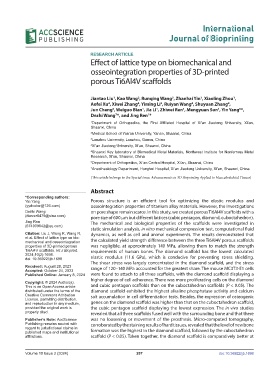Page 215 - IJB-10-2
P. 215
International
Journal of Bioprinting
RESEARCH ARTICLE
Effect of lattice type on biomechanical and
osseointegration properties of 3D-printed
porous Ti6Al4V scaffolds
Jiantao Liu , Kao Wang , Runqing Wang , Zhanhai Yin , Xiaoling Zhou ,
3
1
1
1
2
Aofei Xu , Xiwei Zhang , Yiming Li , Ruiyan Wang , Shuyuan Zhang ,
4
4
4
4
4
Jun Cheng , Weiguo Bian , Jia Li , Zhiwei Ren , Mengyuan Sun , Yin Yang *,
5
6
1
1
1
1
Dezhi Wang *, and Jing Ren *
7
1
1 Department of Orthopedics, the First Affiliated Hospital of Xi’an Jiaotong University, Xi’an,
Shaanxi, China
2 Medical School of Yan’an University, Yanan, Shaanxi, China
3 Lanzhou University, Lanzhou, Gansu, China
4 Xi’an Jiaotong University, Xi’an, Shaanxi, China
5 Shaanxi Key laboratory of Biomedical Metal Materials, Northwest Institute for Nonferrous Metal
Research, Xi’an, Shaanxi, China
6 Department of Orthopedics, Xi’an Central Hospital, Xi’an, Shaanxi, China
7 Anesthesiology Department, Honghui Hospital, Xi’an Jiaotong University, Xi’an, Shaanxi, China
(This article belongs to the Special Issue: Advancements in 3D Bioprinting Applied to Musculoskeletal Tissues)
Abstract
*Corresponding authors:
Yin Yang Porous structure is an efficient tool for optimizing the elastic modulus and
(yydcotor@126.com) osseointegration properties of titanium alloy materials. However, the investigations
Dezhi Wang on pore shape remain scarce. In this study, we created porous Ti6Al4V scaffolds with a
(derver8479@sina.com) pore size of 600 μm but different lattices (cubic pentagon, diamond, cuboctahedron).
Jing Ren The mechanical and biological properties of the scaffolds were investigated in
(674909042@qq.com)
static simulation analysis, in vitro mechanical compression test, computational fluid
Citation: Liu J, Wang K, Wang R, dynamics, as well as cell and animal experiments. The results demonstrated that
et al. Effect of lattice type on bio-
mechanical and osseointegration the calculated yield strength difference between the three Ti6Al4V porous scaffolds
properties of 3D-printed porous was negligible, at approximately 140 MPa, allowing them to match the strength
Ti6Al4V scaffolds. Int J Bioprint. requirements of human bones. The diamond scaffold has the lowest calculated
2024;10(2):1698.
doi: 10.36922/ijb.1698 elastic modulus (11.6 GPa), which is conducive for preventing stress shielding.
The shear stress was largely concentrated in the diamond scaffold, and the stress
Received: August 28, 2023 range of 120–140 MPa accounted for the greatest share. The mouse MC3T3-E1 cells
Accepted: October 24, 2023
Published Online: January 8, 2024 were found to attach to all three scaffolds, with the diamond scaffold displaying a
higher degree of cell adherence. There was more proliferating cells on the diamond
Copyright: © 2024 Author(s).
This is an Open Access article and cubic pentagon scaffolds than on the cuboctahedron scaffolds (P < 0.05). The
distributed under the terms of the diamond scaffold exhibited the highest alkaline phosphatase activity and calcium
Creative Commons Attribution salt accumulation in cell differentiation tests. Besides, the expression of osteogenic
License, permitting distribution,
and reproduction in any medium, genes on the diamond scaffold was higher than that on the cuboctahedron scaffold,
provided the original work is the cubic pentagon scaffold displaying the lowest expression. The in vivo studies
properly cited. revealed that all three scaffolds fused well with the surrounding bone and that there
Publisher’s Note: AccScience was no loosening or movement of the prosthesis. Micro-computed tomography,
Publishing remains neutral with corroborated by the staining results of hard tissues, revealed that the level of new bone
regard to jurisdictional claims in
published maps and institutional formation was the highest in the diamond scaffold, followed by the cuboctahedron
affiliations. scaffold (P < 0.05). Taken together, the diamond scaffold is comparatively better at
Volume 10 Issue 2 (2024) 207 doi: 10.36922/ijb.1698

